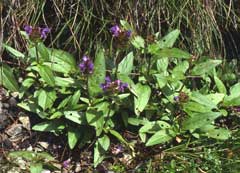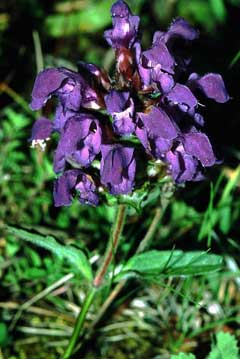 |
|
http://commons.wikimedia.org/wiki/User:Franz_Xaver |
 |
| http://commons.wikimedia.org/wiki/User:Fornax |
Translate this page:
Summary
Physical Characteristics

 Prunella grandiflora is an evergreen Perennial growing to 0.2 m (0ft 8in) by 0.5 m (1ft 8in).
Prunella grandiflora is an evergreen Perennial growing to 0.2 m (0ft 8in) by 0.5 m (1ft 8in).
See above for USDA hardiness. It is hardy to UK zone 5 and is not frost tender. It is in leaf all year, in flower from July to September, and the seeds ripen from August to September. The species is hermaphrodite (has both male and female organs) and is pollinated by Bees.
Suitable for: light (sandy), medium (loamy) and heavy (clay) soils. Suitable pH: mildly acid, neutral and basic (mildly alkaline) soils and can grow in very alkaline soils.
It can grow in semi-shade (light woodland) or no shade. It prefers moist soil.
UK Hardiness Map
US Hardiness Map
Synonyms
P. pyrenaica.
Plant Habitats
Ground Cover; Lawn;
Edible Uses
Edible Parts: Leaves
Edible Uses:
Leaves - raw or cooked[46, 61, 105]. A mild flavour[K].
References More on Edible Uses
Medicinal Uses
Plants For A Future can not take any responsibility for any adverse effects from the use of plants. Always seek advice from a professional before using a plant medicinally.
None known
References More on Medicinal Uses
The Bookshop: Edible Plant Books
Our Latest books on Perennial Plants For Food Forests and Permaculture Gardens in paperback or digital formats.

Edible Tropical Plants
Food Forest Plants for Hotter Conditions: 250+ Plants For Tropical Food Forests & Permaculture Gardens.
More

Edible Temperate Plants
Plants for Your Food Forest: 500 Plants for Temperate Food Forests & Permaculture Gardens.
More

More Books
PFAF have eight books available in paperback and digital formats. Browse the shop for more information.
Shop Now
Other Uses
Can be used as a ground cover plant in a sunny position or light shade[188, 197]. It requires weeding for the first year or so[197]. They are best spaced about 45cm apart each way[208]. Plants have not been a reliable ground cover in Cornwall, often dying after flowering, though they usually self-sow[K].
Special Uses
Ground cover
References More on Other Uses
Cultivation details
Thrives in any damp soil in a shady position[1, 111] or in full sun[200]. Plants are hardy to about -25°c[187]. The sub-species P. grandiflora pyrenaica has larger flowers and is found wild on acid soils whilst the type species is usually found on alkaline soils[187]. Plants tend to be short-lived, often dying out after flowering heavily in the summer[208]. Fortunately, they will usually self-sow freely[K]. Most plants are hermaphrodite but sometimes male plants are found.
References Carbon Farming Information and Carbon Sequestration Information
Temperature Converter
Type a value in the Celsius field to convert the value to Fahrenheit:
Fahrenheit:
The PFAF Bookshop
Plants For A Future have a number of books available in paperback and digital form. Book titles include Edible Plants, Edible Perennials, Edible Trees,Edible Shrubs, Woodland Gardening, and Temperate Food Forest Plants. Our new book is Food Forest Plants For Hotter Conditions (Tropical and Sub-Tropical).
Shop Now
Plant Propagation
Seed - sow in mid spring in a cold frame. When they are large enough to handle, prick the seedlings out into individual pots and plant them out in the summer. If you have sufficient seed then it can be sown outdoors in situ in mid to late spring. Division in spring or autumn. Very easy, larger divisions can be planted out direct into their permanent positions. We have found that it is better to pot up the smaller divisions and grow them on in light shade in a cold frame until they are well established before planting them out in late spring or early summer.
Other Names
If available other names are mentioned here
Native Plant Search
Search over 900 plants ideal for food forests and permaculture gardens. Filter to search native plants to your area. The plants selected are the plants in our book 'Plants For Your Food Forest: 500 Plants for Temperate Food Forests and Permaculture Gardens, as well as plants chosen for our forthcoming related books for Tropical/Hot Wet Climates and Mediterranean/Hot Dry Climates. Native Plant Search
Found In
Countries where the plant has been found are listed here if the information is available
Weed Potential
Right plant wrong place. We are currently updating this section.
Please note that a plant may be invasive in one area but may not in your area so it’s worth checking.
Conservation Status
IUCN Red List of Threatened Plants Status :

Growth: S = slow M = medium F = fast. Soil: L = light (sandy) M = medium H = heavy (clay). pH: A = acid N = neutral B = basic (alkaline). Shade: F = full shade S = semi-shade N = no shade. Moisture: D = dry M = Moist We = wet Wa = water.

Expert comment
Author
(L.)Jacq.
Botanical References
50200
Links / References
For a list of references used on this page please go here
Readers comment
© 2010, Plants For A Future. Plants For A Future is a charitable company limited by guarantee, registered in England and Wales. Charity No. 1057719, Company No. 3204567.